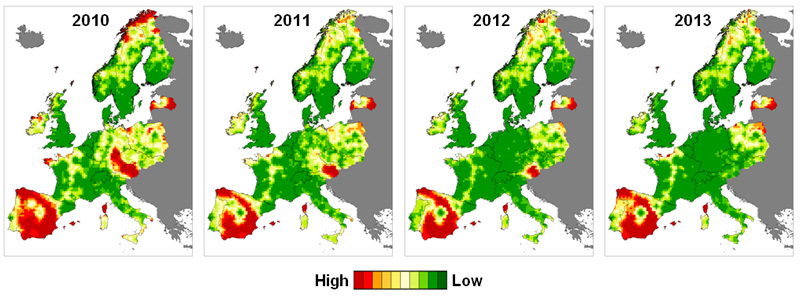Help
Overview
The EBP viewer aims at showing the scope and potential of the EBP project and its future developments. It is, therefore, a first insight about the possibilities of the collaborative work of European on-line bird recording schemes under the auspices of the EBCC.
The EBP viewer shows animated maps depicting the week-by-week distributional patterns of 105 species from 2010 up to now at a resolution of 30x30 km. Each animated map depicts 12 continuous months of data (one year), either the most recent 12 months (LIVE maps), a calendar year or a split year (July to June). Use the time mode selector to choose among these options. The LIVE maps show the last or the previous last 52 weeks of data and are best suited to see the most recent bird movements (data up to the previous day is provided) and to compare them with the previous year. Calendar years are better suited to assess the overall seasonal movements of long distance migrants (i.e. European summer visitors) and split years are better for partial migrants. An additional option, "All years", allows the visualization of the overall seasonal patterns of bird distribution across the different years by combining all the data available since 2010.
There are a total of five types of distributional maps available for each species (see below) and, moreover, four climatic variables can also be selected under the section "Contextual data".
Two visualization modes are available: one depicting a single zoomable map and the other one showing a double map (default option). The later allows two animated maps to be shown simultaneously for direct comparison which, given the number of species, types of maps and years available, means that more than 50 million different map combinations are available to choose from.
Maps
The species maps shown in the EBP demo viewer are based on 320 million bird records collected since 2010 by the on-line bird recording portals run by the project partners. The EBP central database repository aggregates these data by week and 30x30 km square (based on the European Environment Agency reference grid ETRS89-LAEA) summarizing information on the number of observations of each species, the number of counted birds and the recording effort (number of complete lists and total number of records and observers). Four of the species maps (occurrence, traces, counts and phenology) reflect, in different ways, the raw information contained in the aggregated data, while the fifth one (corrected regional occurrence) uses various analytical procedures to account for heterogeneity in observational effort and species reporting rates.
Thanks to the implementation of an automatic data flow system, most EBP partners submit their data to the EBP central database repository on a daily basis (86%) and, therefore, all maps shown in the viewer are also updated on a daily basis using the most up to date information.
The maps depicting climatic variables have been prepared using the E-OBS high-resolution gridded dataset v10.0. Like species maps, the original E-OBS dataset is aggregated by week and 30x30 km square.
In all cases, only those 30x30 km squares including terrestrial areas are shown in the maps.
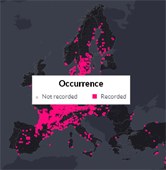
Occurrence map
These maps show the 30x30 km squares where the selected species was recorded or not each week. Note that not all species detected end up being reported and, thus, the absence of records in a given square does not automatically mean that the species was not observed there.

Traces map
These maps show the 30x30 km squares where the selected species has been recorded during each week but also during the two previous ones, enhancing the visualization of rapid temporal changes in distribution and their “traces” over time. Note that not all species detected end up being reported and, thus, the absence of records in a given square does not automatically mean that the species was not observed there.
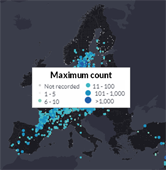
Counts map
These maps show the maximum count recorded for the selected species in each 30x30 km square and week (in "All years" maps, the average of the maximum count of each year is shown). Note that the original counts used to obtain these figures mostly refer to casual counts or rough estimates of the number of birds detected in a given site and date. Only rarely they refer to formal censuses or exhaustive counts. These maps, therefore, only show a rough approximation of the real variability in bird numbers across space and time. Also take into account that not all species detected end up being reported and, thus, the absence of records in a given square does not automatically mean that the species was not observed there.

Corrected regional occurrence (CRO) map
These maps make use of a complex set of spatial and temporal aggregation and smoothing procedures to account for differences in observational effort and reporting activity of the observers (click here for further details). They are specifically intended to help visualize large-scale temporal changes in bird distribution and thus they should not be interpreted at a local scale. For each 30x30 km square and week these maps depict the estimated regional frequency of occurrence of the selected species. Modelling the spatial and temporal dynamics of bird distributions is one of the main but challenging objectives of the EBP project. This work is underway and, therefore, it has to be stressed that the maps shown here are very preliminary.
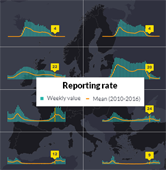
Phenological map
These maps depict the phenology of the selected species in seven different geographical sectors according to the percentage of 30x30 km squares where the species has been recorded in each sector and week.
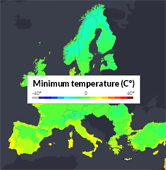
Minimum temperature map
These maps show the minimum temperature for each 30x30 km square and week (recalculated from E-OBS high-resolution gridded dataset v10.0). In "All years" maps, the average of the minimum temperature of each year is shown.
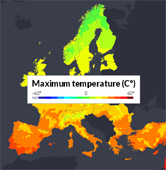
Maximum temperature map
These maps show the maximum temperature for each 30x30 km square and week (recalculated from E-OBS high-resolution gridded dataset v10.0). In "All years" maps, the average of the maximum temperature of each year is shown.

Mean temperature map
These maps show the mean temperature for each 30x30 km square and week (recalculated from E-OBS high-resolution gridded dataset v10.0). In "All years" maps, the average of the mean temperature of each year is shown.
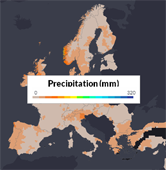
Precipitation map
These maps show the total precipitation amount for each 30x30 km square and week (recalculated from E-OBS high-resolution gridded dataset v10.0). In "All years" maps, the average of the total precipitation amount of each year is shown.
Data accuracy and interpretation
Each on-line bird recording scheme submitting data to the project has its own data validation protocols to deal with potentially erroneous observations. Moreover, additional data quality checks are conducted at the EBP level. However, overall, the EBP demo viewer synthesises more than 320 million bird records in about 55,000 weekly maps. These are too large numbers to completely discard the possibility that some erroneous observations could still be present in some maps. This can be particularly the case in LIVE maps since the data shown can be so recent (e.g. from the previous day) that some erroneous records or counts may not have been detected yet. Once corrected, the system automatically deals with these errors in subsequent data updates. However, the possibility that some erroneous observations could remain unnoticed cannot be completely discarded.
The possible existence of some erroneous records or counts, however, shouldn't distort the overall large-scale patterns of bird distribution shown in the viewer, which is the ultimate interest of the EBP project.
Rather than the possible presence of a few erroneous observations, it is the interpretation of the maps itself that requires an important cautionary note. On-line bird recording portals mainly obtain data from the relatively unstructured but intensive and widespread activities of birdwatchers. This means that surveying effort can differ largely from one area to another (even very close ones) or from one week to the next. It is even more relevant that the willingness to report a given species can vary significantly among sites, weeks and the rarity of the species (observers tend to report more often a given species in areas or periods of the year where it is less usual or common). Accordingly, a lack of records of a given species in a given surveyed square and week does not automatically mean that the species was not observed there (it may have been observed but not reported).
In many cases, the advice of an expert and further analyses may be required to draw sound conclusions from these maps. The EBP, therefore, can't be made responsible of the inadequate use of the information contained in the viewer or its interpretation by third parties (see also Disclaimer).
Note that records of rare species which don't seem unreliable but which are still under formal revision by the corresponding Regional or National Rarities Committees are also included in the maps. Certainly, some of these records could end up being not accepted by the respective committee. However, the reviewing protocols differ among committees and partners and in some cases the process can take several months and, therefore, not including of these observations could artificially alter the seasonal patterns of distribution of these species. In any case, these considerations should always be taken into account when interpreting the maps of these particular species.
Data use by third parties
The EBP data repository collects the information provided by the EBP partners on-line bird recording portals using the EBP data sharing standard. The Rules of the EBP data repository establish, in line with the EBP agreement, the conditions in which EBP data can be used to create the products developed for the own interest of the EBP partnership as well as those developed by the request of third parties.
Requests from third parties to use EBP data should be sent to the EBP coordinator indicating the characteristics of the data requested (geographical area, species, type of information and years) and those of the research project (e.g. institutions involved, funding availability, overall objectives and intended use of the EBP data).
Key characteristics of the data available in the EBP data repository:
Time period | 2010 to present |
Geographic coverage | EU member states (except Malta), Andorra, Israel, Norway, Russia, Switzerland, Turkey, UK. |
Data type | Records (species, count, breeding evidence) with contextual information (e.g. date, location). (cf. EBP data sharing standard for a detailed description) |
Temporal resolution | Date (casual records and part of lists) or date and time interval (part of lists) |
Seasonal coverage | Year-round |
Spatial resolution | Exact location/10x10 km square |
Taxonomic coverage | Currently 137 species (all species will be available during 2025) |
Frequency of update | Data updated daily with information up to the previous day (99% of the data) |
Disclaimer
This website is hosted by the Catalan Ornithological Institute on behalf of the EuroBirdPortal project (EBP), an initiative of the European Bird Census Council (EBCC), a not-for-profit organization located in Nijmegen, The Netherlands.
Using this website requires agreeing with the following:
- The content, information and maps shown in this website are provided in good faith and for informational purposes only. They do not constitute any advice or recommendation in itself and no warranties are given regarding the same.
- EBCC is not responsible for errors that may contain the information provided on this website or the consequences that may result from the use or interpretation thereof.
- The boundaries, colours, denominations or other information shown on maps do not imply any judgement on the part of EBCC concerning the legal status of any territory, or the endorsement or acceptance of such boundaries. Users must observe the copyright and licensing provisions included with all maps.
Acknowledgements
The maps shown in the EBP demo viewer are possible thanks to the activity of several thousands volunteer birdwatchers that submit their observations to the on-line bird recording schemes run by the EBP partners. Without their continuous contribution in time, effort and expertise the EBP project would be unfeasible. Our big thanks to all of them.
The financial support of the Swiss Ornithological Institute has been decisive for the implementation of the demo viewer and to undertake the first steps of the EBP project.
EBP data modelling and analysis are developed in collaboration with the Centre Tecnologic Forestal de Catalunya (CTFC) and the EUBON project (EU grant agreement No 308454). Moreover, data modelling also counted with funding from the Department of the Environment of Luxembourg.
The LIFE EBP project is co-financed by the European Commission Directorate General for the Environment and the Directorate-General of Telecommunications and Information Society of the Government of Catalonia, and each of the project beneficiaries.
Working with the top-notch location intelligence and data visualization platform, CartoDB, has been crucial to transform information into great insights.
Our thanks also to the people at Topxel for their excellent work with the EBP logotype and with the visual design of this new version of the EBP vierwer.
Many thanks also to Toni Llobet and Martí Franch for the nice drawings that illustrate the bird species shown in the viewer.
We acknowledge the E-OBS dataset from the EU-FP6 project ENSEMBLES and the data providers in the ECA&D project (Haylock, M.R., N. Hofstra, A.M.G. Klein Tank, E.J. Klok, P.D. Jones, M. New. 2008: A European daily high-resolution gridded dataset of surface temperature and precipitation. J. Geophys. Res., 113, D20119, doi:10.1029/2008JD10201 ).











